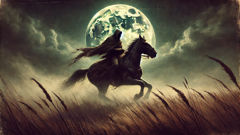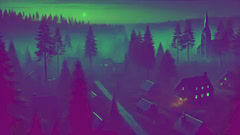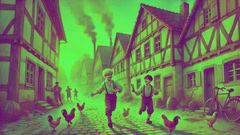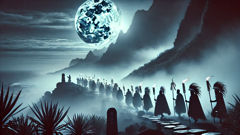Introduction
In the vast, open plains of South Texas, where mesquite trees twist against the wind and the tall prairie grasses ripple like golden waves beneath an endless sky, whispers have always drifted on the night breeze. Among the ranchers and vaqueros, beneath the bluebonnets and the shadow of ancient live oaks, there is one story that has seeped deeper than all the rest—one that makes even the bravest hesitate as dusk falls. They speak of a phantom horseman, a rider whose headless silhouette is seen galloping across the moonlit chaparral, his coat flapping wildly behind him and his mount’s hooves pounding out a warning no living soul dares to ignore. Old-timers will tell you it’s not just a story to scare the children. This is the legend of the Headless Horseman of Texas—a tale woven from greed, vengeance, and the unbreakable spirit of the land. The legend’s roots tangle through the harsh years of cattle drives and border wars, when fortunes were made and lost overnight, and justice was often a matter of survival. The story’s details shift with each retelling, yet all agree: long ago, a cunning horse thief known as Arturo del Río met his grisly fate under a pale, watchful moon, and ever since, his restless spirit has haunted these plains. Some say his curse was born of betrayal, others whisper it was vengeance that chained him to the earth. All know to give the open range its due respect at night, for beneath the stars, the past still rides, unyielding and silent, seeking an end that will never come.
The Birth of a Legend
The year was 1867, and the South Texas plains lay restless under the summer’s sun. The land, rich with wild mustangs and promise, was also a crossroads for fortune-seekers and outlaws alike. Among them rode Arturo del Río, a man whose name became as infamous as the dust storms that swept through the chaparral. Arturo was a master horseman, his hands sure and his eyes sharp, but it was his daring that set him apart—a daring that too often strayed into lawlessness. He was a horse thief, but not just any; his reputation stretched from San Antonio to Brownsville, and even the most vigilant ranchers grew anxious when his shadow darkened their fence lines. Arturo moved with the ease of someone born in the saddle. With his small gang—men as desperate as they were loyal—he’d slip into ranches in the dead of night, cutting out prized stallions and vanishing before dawn left a trace. He was clever, never greedy enough to take too many, never violent unless pressed. Some called him a Robin Hood, claiming he shared with the poor; others spat when his name was spoken. Yet no one doubted his skill or nerve.
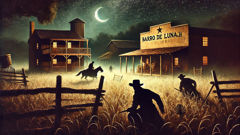
On one fateful August night, with cicadas singing their relentless song and the air heavy with heat, Arturo targeted the sprawling Barro de Luna ranch. Its owner, Don Rafael Cordero, was both respected and feared—a former soldier who’d carved his fortune from the wilds with grit and a quick trigger. His stables, it was said, held the finest Andalusian bloodlines this side of Mexico. Arturo had heard the tales and, as he watched from the shadows, the urge for one last great score overruled his caution. With practiced silence, he and two companions crept across the hard-packed earth, their boots muffled by the grass. Lanterns glowed in the distance, but the main house was asleep. The stables, however, were not empty. Don Rafael’s men, wary after recent thefts, had doubled the watch. Arturo saw the shapes—two men, rifles slung over their shoulders, circling the corral. Still, he pressed on. As he slipped a halter over a silver-gray stallion’s head, the horse shifted and snorted, betraying him. A voice barked out; a shot cracked. Arturo vaulted into the saddle, the stallion plunging forward as chaos erupted. His companions scattered, but Arturo rode hard, bullets kicking up dust around him. He vanished into the thickets, the shouts fading behind.
But Don Rafael was not a man to let insult stand. He rallied his men and gave chase, following tracks etched into the earth. For hours they hunted, through rivers and canyons, until finally, at dawn’s pale edge, they cornered Arturo near a dry creek bed. Outnumbered and with no way out, Arturo fought like a trapped coyote, but it was no use. Don Rafael himself delivered the final blow—a swift, brutal justice that left Arturo’s body sprawled in the dust. As a warning to other thieves, they cut his head from his shoulders and displayed it on a post near the ranch gate. The body was buried in an unmarked grave, the head left to the vultures. The message was clear: trespassers would pay in blood. The plains went quiet. For a time, all was still.
Restless Shadows on the Plains
It was weeks after Arturo’s execution when the whispers began. It started with a ranch hand, returning late from the fields. He swore he saw a rider moving fast across the low hills—a rider who wore no hat and, more disturbingly, seemed to have no head at all. At first, no one believed him. The plains breed stories as easily as wildflowers, after all. Yet as summer deepened, more reports trickled in: horses found sweating and wild-eyed at sunrise; distant hoofbeats echoing in the stillness; a cold wind that made even the bravest men shiver. The sightings grew bolder. Some described a phantom figure draped in a tattered serape, blood darkening its collar, astride a black stallion with eyes like burning coals. The rider’s headless form would appear at the edge of a firelight, then vanish without a sound. Dogs howled and cattle stampeded for no reason on moonless nights.
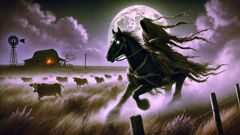
Don Rafael’s men grew uneasy. Some quit outright, refusing to work after sundown. The legend took root, nourished by fear and superstition. Mothers began to warn their children not to stray too far after dark, lest the Headless Horseman find them. As the autumn rolled in, bringing chill winds that rustled the cottonwoods, the haunting intensified. More than one vaquero vanished on night patrols, their bodies discovered days later with faces twisted in terror, yet without a mark. Horses were found with strange wounds—long scratches down their flanks, as if clawed by unseen hands. The Cordero family’s luck seemed to turn: crops failed, wells went dry, and storms battered the ranch. Don Rafael tried to dismiss it as coincidence, but his household grew tense. His own daughter, Isabella, claimed to see a shadowy rider at her window. He doubled the guards and kept his pistol close.
One night, Don Rafael himself encountered the specter. Woken by a distant, unearthly neighing, he stepped onto his porch, only to see the headless horseman galloping across the distant ridge, moonlight shining on an empty neck. A chill settled in his bones. That same night, the stallion Arturo had stolen—the pride of Barro de Luna—broke free and was never seen again. The legend spread beyond the ranch, whispered from campfires to cantinas across South Texas. Some believed Arturo’s restless soul sought vengeance, others that he was cursed for his crimes. Still others said he was simply searching for his lost head, doomed to ride until it was returned. Whatever the reason, the headless rider became a part of the land itself, an omen carried on every wind.
A Reckoning in the Night
Years passed, and the legend of the Headless Horseman only grew. New settlers brought their own stories and fears, but always the same warning was repeated: never cross the plains at night alone. Yet not all believed. In 1875, a young cowboy named Elias Montoya arrived in South Texas, drawn by tales of rich ranches and adventure. Elias was skeptical of ghost stories. He’d seen enough hardship on the frontier to believe that most evils wore a human face. Hired on at a neighboring ranch, he laughed at the tales spun around the fire. But curiosity has a way of testing even the bravest souls.
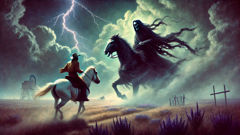
One autumn evening, with the air tinged by the scent of rain and mesquite smoke, Elias found himself riding home late after helping mend a distant fence line. The prairie was quiet but for the creak of saddle leather and the soft thud of his horse’s hooves. Then came a distant rumble—not thunder, but the unmistakable beat of galloping hooves. Elias reined in, peering into the gloom. From the shadows emerged the infamous figure: a rider clad in dusty black, his shoulders broad and his neck ending in torn cloth soaked with old blood. No face met Elias’s gaze—only emptiness where a head should be.
The stallion the ghost rode was larger than any horse Elias had seen, black as pitch with a mane like smoke. The air grew cold. Elias’s horse reared and whinnied in terror, nearly throwing him. The headless rider charged, silent and relentless. Elias spurred his mount away, heart pounding, but the phantom seemed to float above the ground, gaining with every stride. Panicked, Elias remembered the stories—some said you must show respect to the dead. He turned in his saddle and shouted into the night: “I mean you no harm! May your soul find peace!”
The horseman slowed, his mount’s eyes flickering with unnatural fire. For a moment, Elias thought he saw a hand raise as if in thanks—or warning. Then the phantom wheeled and vanished into the swirling mist, leaving Elias trembling but alive. He never again doubted the legends and became one of their fiercest keepers. News of his encounter spread quickly. Others came forward with their own stories—some claimed the horseman could not harm those who respected the dead, others believed he appeared to warn of coming misfortune. The legend deepened its roots. In time, those who sought to exploit the land or disrespect its people found themselves haunted by dreams of a headless rider. Some vanished without a trace. For those who lived in harmony with the plains, however, the specter became less a terror and more a guardian—a reminder that justice sometimes comes from unexpected places.
Conclusion
Today, the legend of the Headless Horseman of Texas endures. The land has changed—barbed wire fences snake across the hills, towns have blossomed where only prairie once rolled—but some nights, when the wind moans through the chaparral and coyotes howl under the moon, old-timers swear they still see a shadow racing across the horizon. They say the horseman rides on not out of malice, but as a warning—a restless spirit demanding respect for the land and its people, reminding all that justice is not always delivered by human hands. Tourists and locals alike gather each fall to tell the tale anew, their voices echoing across generations. Some light candles at crossroads or leave flowers where Arturo del Río is said to have fallen, hoping to ease his troubled soul. Children dare each other to walk the fence line at dusk, and every rancher knows to check their gates and whisper a prayer before sleep. The story may have begun in blood and betrayal, but it has grown into something larger—a living thread woven into the fabric of South Texas itself. For as long as the prairies stretch beneath the stars, and as long as men seek fortune and justice on this wild land, the Headless Horseman will ride on, silent and watchful, a legend unbroken by time.

